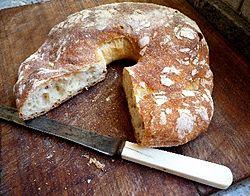Ftira facts for kids

Ftira
|
|
| Type | Bread |
|---|---|
| Place of origin | Malta |
| Variations | Gozitan open ftira |
Ftira is a special ring-shaped bread from Malta. It's a type of leavened bread, which means it uses yeast to make it rise and become fluffy. People in Malta often eat ftira filled with tasty ingredients.
Common fillings include sardines, tuna, potato, fresh tomato, onion, capers, and olives. It's a bit like a sandwich, but with a unique Maltese twist!
Contents
Types of Ftira
There are different ways to enjoy ftira. The most common is the ring-shaped bread used for sandwiches.
Gozitan Ftira
If you visit Gozo, another island near Malta, you'll find a different kind of ftira. Gozitan ftira is served open, more like a pizza. It often has thinly sliced potato on top of the crust. Sometimes, it's folded over, similar to a calzone.
Ftira: A Special Heritage
The Maltese ftira is more than just bread; it's an important part of Malta's culture. It has even been recognized by UNESCO, a special organization that promotes education, science, and culture around the world.
What is Intangible Cultural Heritage?
UNESCO has a list called "Intangible Cultural Heritage" (ICH). This list includes traditions, customs, skills, and knowledge that are passed down through generations. It's about living heritage, not just old buildings or objects. Think of it as the "heart and soul" of a culture.
How Ftira Became a Heritage Item
In 2018, the Parliament of Malta agreed to join UNESCO's efforts to protect cultural heritage. After this, Malta's Culture Directorate started a project to get the Maltese ftira added to the ICH list.
A Long History
Experts believe that "The Making of the Ftira Maltija" dates back to the 16th century. This shows how old and important this bread is to Maltese history.
Public Support and Recognition
There was a big public campaign to support the ftira's nomination. The Maltese government then officially submitted the ftira to UNESCO. In 2020, the hard work paid off! The Maltese ftira was successfully added to UNESCO's Intangible Cultural Heritage List. This means it's now recognized worldwide as a special cultural tradition.
See also
- In Spanish: Ftira para niños

